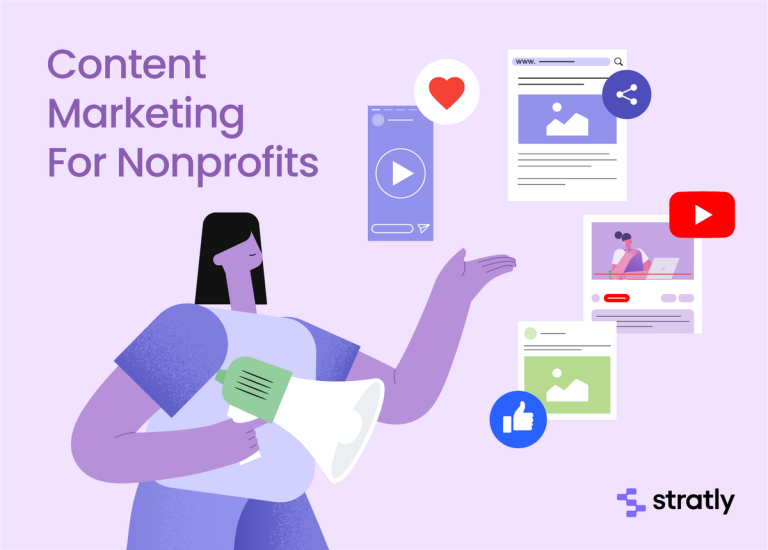Content marketing for nonprofits can sound a bit overwhelming. You’re probably thinking, “Great, another marketing buzzword I need to learn.” But hold up, it’s not as complicated as it seems.
For nonprofits striving to create a significant impact, content marketing stands out as an invaluable tool. Instead of relying on flashy advertisements or empty slogans, focus on producing genuine content that speaks directly to people’s hearts and encourages action.
The best part? You don’t need a huge budget or an army of marketing experts to get started. With some creative thinking and clever strategies, even small nonprofits can use content marketing to connect with more people, build better relationships, and achieve their goals.
Today we’ll cover:
- Understanding the Importance of Content Marketing for Nonprofits
- Creating a Content Marketing Strategy for Nonprofits
- Leveraging Social Media for Nonprofit Content Marketing
- Crafting Compelling Nonprofit Content
- Effective Content Marketing for Nonprofits Relies on a Powerful CRM
Understanding the Importance of Content Marketing for Nonprofits
So, what is content marketing all about? It’s a plan to make and share meaningful, steady content (think blogs, social media posts, videos, etc.) that grabs the attention of your target audience.
Benefits of Content Marketing for Nonprofits
For nonprofit organizations, content marketing has lots of advantages. Creating content that is both engaging and valuable enables you to:
- Increase brand awareness and reach a wider audience.
- Engage supporters and build a loyal community.
- Attract potential donors and volunteers.
- Establish your organization as a thought leader in your space.
- Educate people about your cause and inspire them to take action.
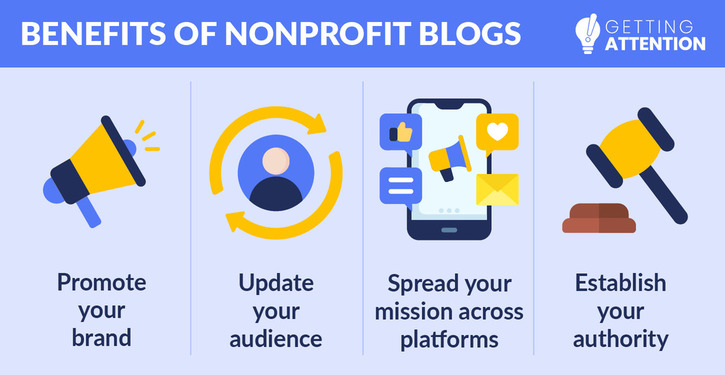
Defining Your Nonprofit’s Content Marketing Goals
First things first—define what success looks like in your nonprofit’s content marketing efforts.
For you, success could be:
- Increasing website traffic and engagement.
- Growing your email subscriber list.
- Driving donations and fundraising.
- Recruiting volunteers and advocates.
- Raising awareness for a specific campaign or initiative.
Your goals should be specific, measurable, achievable, relevant, and time-bound (SMART).
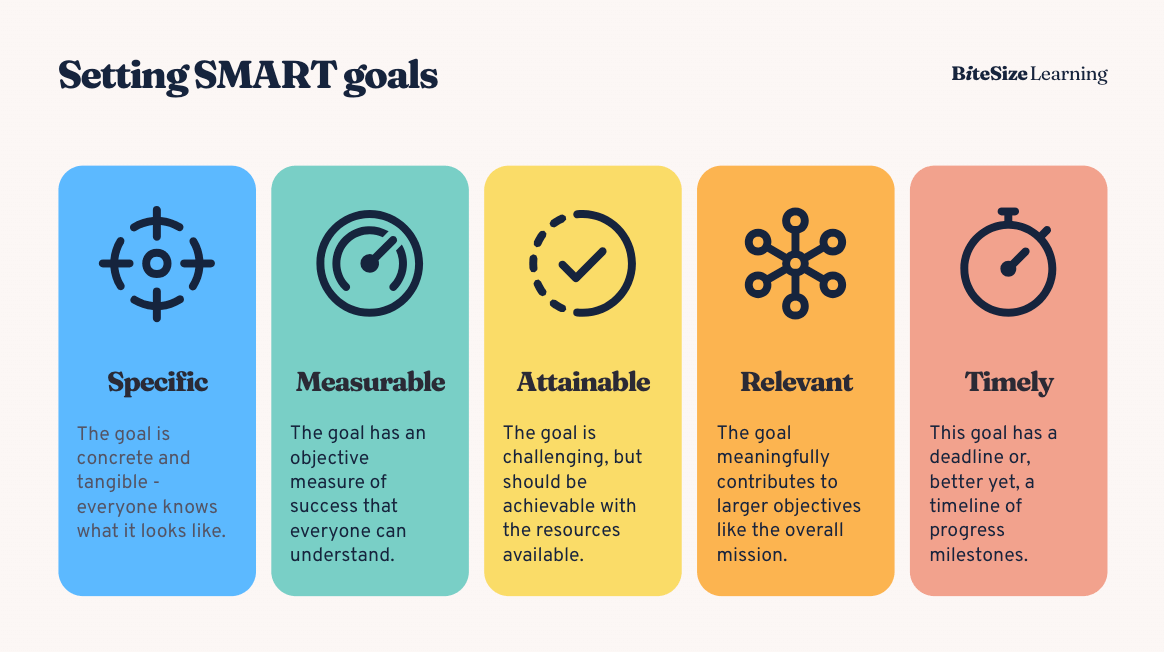
For example, instead of simply aiming to “increase website traffic,” set a goal to “increase website traffic by 25% within the next 6 months through targeted SEO strategies.”
Creating a Content Marketing Strategy for Nonprofits
You know the importance of content marketing for nonprofits and you’ve got your goals lined up—great.
Next step? Crafting a solid strategy.
With this in place, you’ll have a clear roadmap for producing, distributing, and measuring your efforts so every resource counts toward achieving what you want.
Identifying Your Target Audience
The first step in developing your nonprofit content marketing strategy is identifying your target audience. Who are you trying to reach with your content? Consider factors like:
- Demographics (age, gender, location, etc.)
- Interests and behaviors
- Challenges and pain points
- Preferred content formats and channels
Understanding your target audience starts with creating personas. This method enables you to develop content that deeply resonates with them. For instance, if your nonprofit is all about animal welfare, you’d want to connect with folks who adore animals, own pets themselves or care deeply about supporting organizations like yours through donations.
Creating a Content Calendar
A content calendar is essential for managing various marketing initiatives and scheduling content distribution effectively. This is key to ensuring strategies work and nonprofit marketing teams are on the same page with content strategy and general marketing strategies.
You can:
- Plan content themes and topics in advance
- Ensure a consistent publishing schedule
- Align content with key dates, campaigns, and events
- Collaborate with team members and stakeholders
Your editorial calendar should include details like content titles, formats, target keywords, publication dates, distribution channels, and any necessary resources or assets. This information should be included in a greater nonprofit marketing plan where you house everything for your nonprofit marketing including email marketing, events, fundraisers, etc.
Choosing the Right Content Formats
Here are a few content formats to consider including in your nonprofit marketing plan and content strategy:
- Blog posts and articles
- Videos and vlogs
- Infographics and data visualizations
- Case studies and success stories
- Newsletters and email campaigns
- Social media posts and campaigns
- Webinars and virtual events
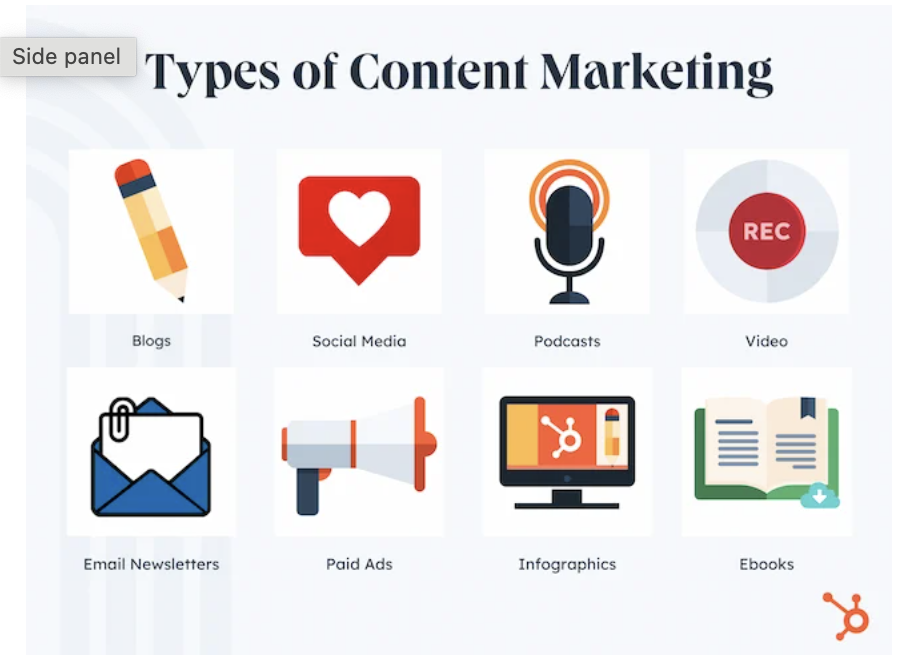
Optimizing Content for Search Engines
Getting your content noticed on search engines is a big part of any marketing strategy. By using the right keywords, you can boost your spot in search results and draw more visitors to your site.
For nonprofits, some top SEO tips include:
- Conducting keyword research to identify high-value, relevant keywords.
- Incorporating keywords naturally into your content, including titles, headings, and body copy.
- Optimizing meta titles and descriptions to improve click-through rates.
- Using header tags (H1, H2, etc.) to structure your content and signal importance to search engines.
- Building high-quality, relevant backlinks to your content from other reputable websites.
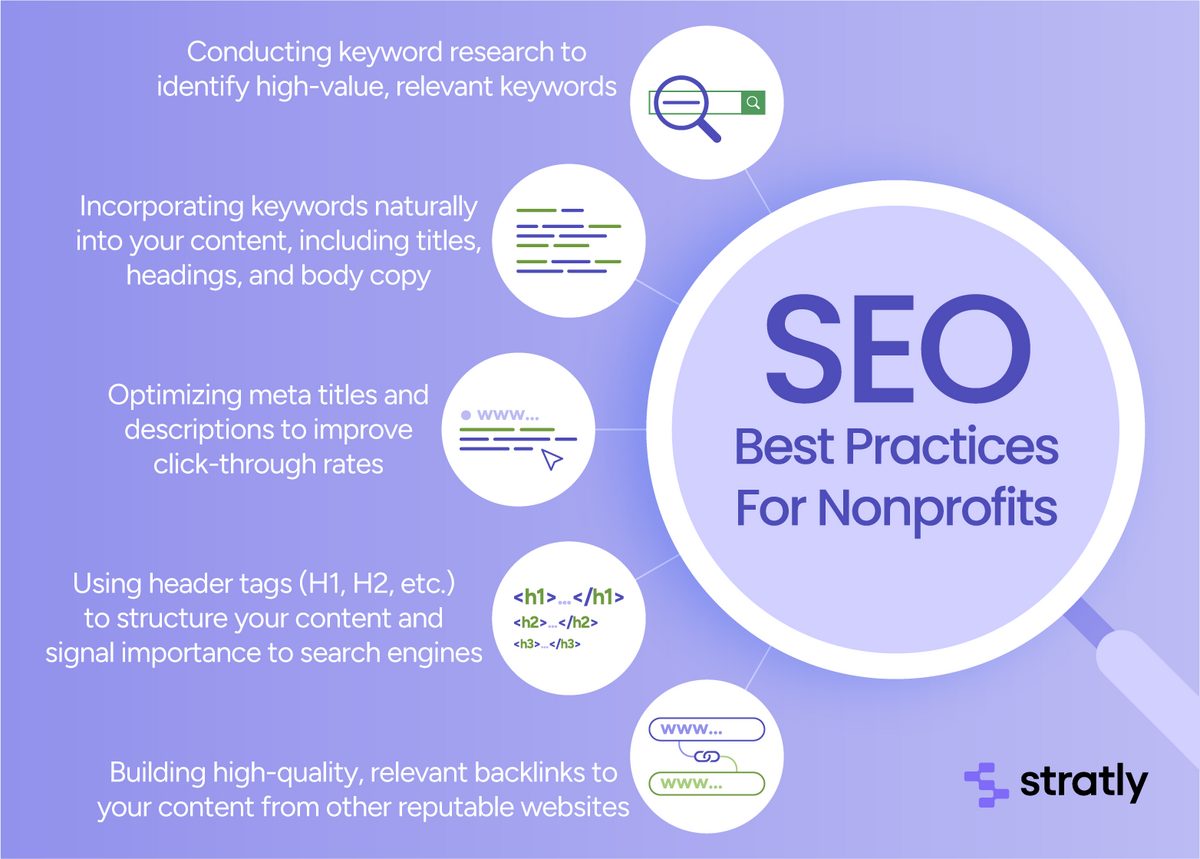
Stick to these best practices and keep creating content that’s valuable and packed with the right keywords. Doing this will boost your search engine rankings, bringing more interested visitors to your nonprofit’s website.
Measuring and Analyzing Your Content Marketing Results
Don’t forget to keep an eye on your content marketing results. By tracking key metrics, you’ll see what hits the mark and what falls flat.
- Website traffic and engagement (pageviews, time on page, bounce rate, etc.).
- Social media metrics (followers, likes, shares, comments, etc.).
- Email marketing metrics (open rates, click-through rates, conversions, etc.).
- Conversion rates (donations, volunteer sign-ups, email subscriptions, etc.).
You should use Google Analytics along with social media analytics and email platforms to monitor your progress closely.
Leveraging Social Media for Nonprofit Content Marketing
Social media has revolutionized content marketing for nonprofits. It’s where many of your supporters hang out, connect with causes they care about, and share information with their friends.
But with so many social media platforms out there, how do you choose the right ones for your nonprofit?
Choosing the Right Social Media Platforms
Different social media platforms serve different purposes. To make the most impact, focus on where your target audience spends their time.
For example, if you’re targeting a younger demographic, Instagram and TikTok might be your best bet. But if you’re trying to reach professionals or decision-makers, LinkedIn could be a better fit.
When picking your platforms, think about things like usability, audience reach, and the type of content you want to share.
- Demographics of your target audience.
- Type of content you plan to create.
- Goals of your social media strategy.
Creating Engaging Social Media Content
Once you’ve chosen your platforms, it’s time to start creating content that will stop the scroll. Engaging social media content is:
- Visual: Use eye-catching images, graphics, and videos.
- Authentic: Showcase the real people and stories behind your cause.
- Actionable: Include clear calls-to-action like “donate now” or “sign the petition”.
- Shareable: Create content that people will want to share with their followers.
Remember, social media is all about making connections. Don’t just push out your message – join the conversation, reply to comments, and let people see the human side of your organization.
Building a Social Media Community
Your social media followers are more than just numbers – they’re a community of supporters who believe in your cause.
To build a strong community:
- Encourage user-generated content by asking followers to share their stories and experiences.
- Host live events like Q&A sessions or virtual fundraisers.
- Collaborate with influencers or other nonprofits in your space.
- Create exclusive content or perks for your most engaged followers.
An engaged community can amplify your message, attract new supporters, and create a meaningful impact in the world.
Measuring Social Media Success
Wondering if your social media efforts are making a difference? You need to track the right metrics. For nonprofits, some important ones include engagement rates and follower growth.
- Engagement rate (likes, comments, shares).
- Click-through rate to your website or donation page.
- Follower growth over time.
- Reach of your posts (how many people are seeing your content).
To monitor how you’re doing, use platforms such as Google Analytics, along with built-in analytics from social media sites. Adjust your approach based on what you find out.
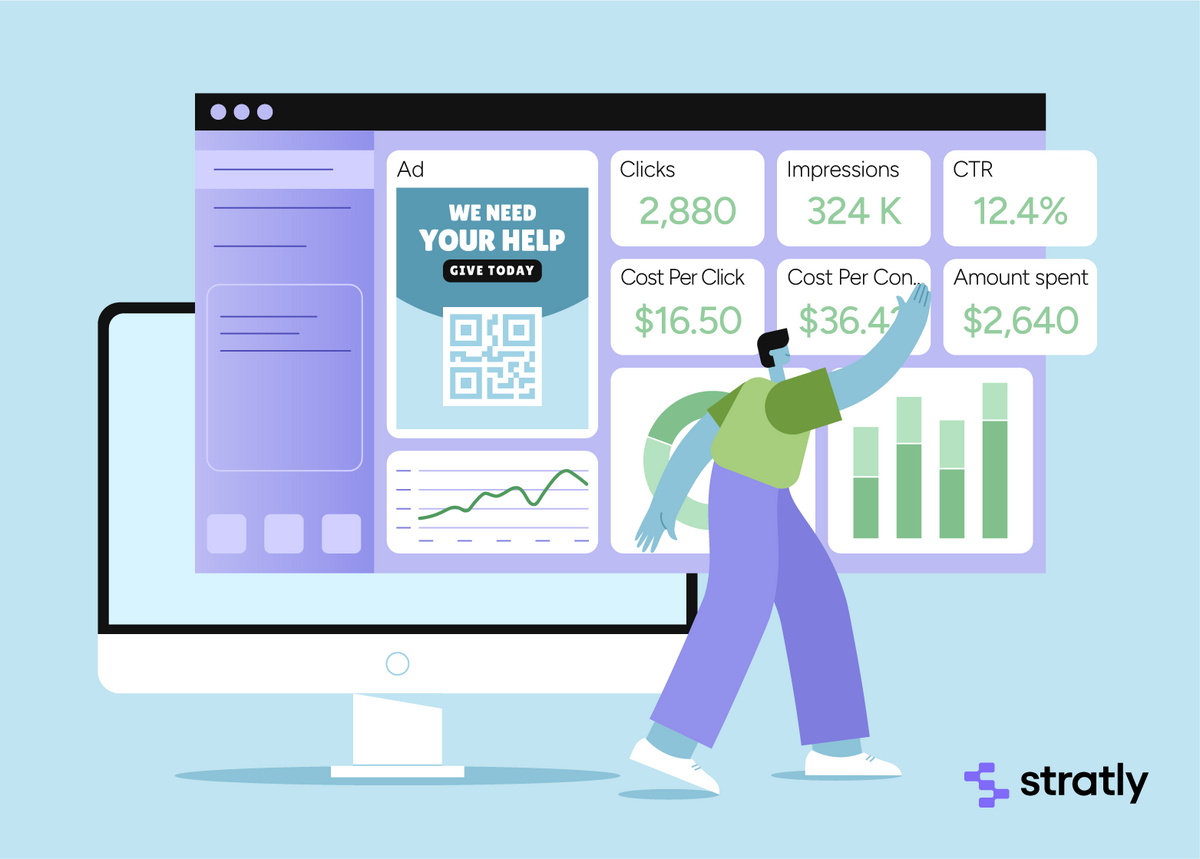
Crafting Compelling Nonprofit Content
Content is the fuel that drives your nonprofit marketing engine. But not just any content will do – you need to craft compelling stories, messages, and experiences that inspire action.
Through my experience as a nonprofit content marketer, I’ve discovered that putting people at the center is crucial for engaging material. Let’s look at several effective types:
Creating Informative Blog Posts
Nonprofit organizations rely on blog posts for content marketing because they effectively educate readers, demonstrate expertise, and boost site traffic.
If you’re crafting blog posts, make sure the subjects you choose resonate with your target audience and provide them with real benefits.
Consider these ideas:
- How-to guides or tutorials related to your cause.
- Opinion pieces or commentary on current events.
- Interviews with experts or thought leaders in your field.
- Behind-the-scenes looks at your organization’s work.
To get more eyes on your blog posts, make sure you add the right keywords, craft engaging meta descriptions, and use appropriate header tags. Promoting these posts on social media can also help bring a larger audience to your nonprofit’s website.
Designing Engaging Annual Reports
Though annual reports aren’t exactly exciting, they’re essential for highlighting what you’ve achieved and building credibility with those who support you.
If you want an engaging annual report, concentrate on:
- Highlighting key accomplishments and milestones from the past year.
- Using infographics and data visualizations to make complex information easy to understand.
- Including personal stories and testimonials from people you’ve helped.
- Making it visually appealing with high-quality photos and design elements.
Create a digital version of your annual report so it’s simple to share on the internet. Break it down into bite-sized content such as social media updates or short blog entries for better engagement.
Producing Impactful Video Content
Video can really boost your nonprofit’s content marketing efforts. It’s perfect for capturing emotion, demonstrating what you do firsthand, and adding a human touch to your mission.
Some types of video content to consider:
- Short social media videos (like Instagram Reels or TikToks).
- Longer-form storytelling videos (like mini-documentaries or impact stories).
- Livestreams or webinars.
- Animated explainer videos.
When you’re making video content, remember a few key things:
- Attention spans are short – aim for videos that are 2 minutes or less.
- Use captions or subtitles for accessibility.
- Invest in decent equipment (like a smartphone gimbal or external microphone).
- Include a clear call-to-action at the end of your videos.
Developing Interactive Web Content
Interactive content can really pull your audience in and get them to stick around longer on your website. Think about quizzes, polls, or even interactive infographics as great examples.
- Quizzes or assessments related to your cause.
- Interactive infographics or data visualizations.
- Virtual tours or 360-degree videos.
- Calculators or tools (like a carbon footprint calculator for an environmental nonprofit).
Interactive web content might be more demanding to put together compared to other forms of content, yet its impact is often greater. It’s also fantastic for collecting valuable insights on your audience.
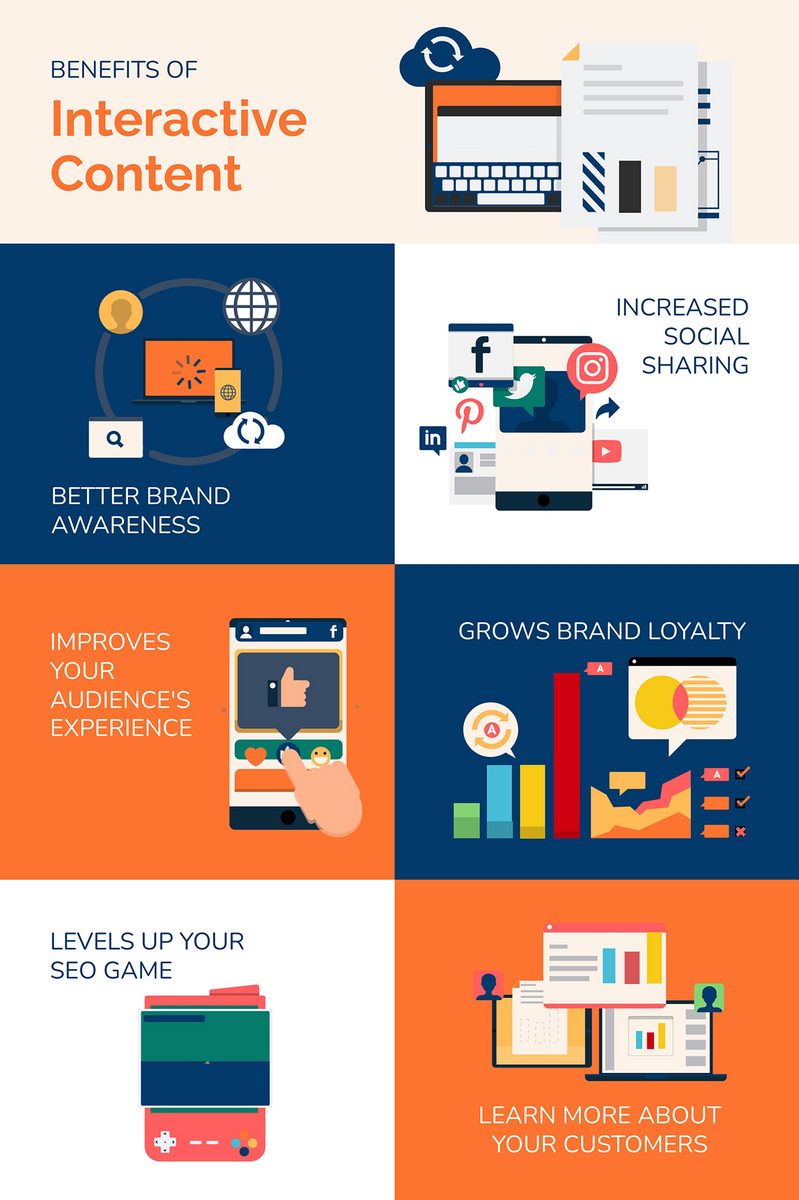
No matter what type of content you’re creating, remember to keep your audience and your goals in mind. Every piece of nonprofit content should have a clear purpose and a measurable outcome.
Effective Content Marketing for Nonprofits Relies on a Powerful CRM
Content marketing for nonprofits isn’t some mystical art reserved for the big players. It’s a powerful tool that any organization can use to make a real difference.
But, the key is having a CRM on your side that can make it simpler for your nonprofit marketing team.
Automated emails, drag-and-drop website building, personalization and customization for content, donation tracking, etc. are just a few of the important features of a nonprofit CRM that will help nonprofit professionals with content marketing.
For that reason, nonprofits turn to us often. Stratly features all this and more. Book your demo today!

